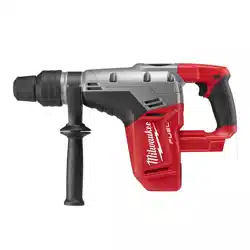Loading ...
Loading ...
Loading ...

6
NOTE: If unable to drill a hole
Pull bit out as far
as possible onc
e
or twice per inc
h
drilled.
in the kerf, pull back on the bit
with the hammer running. This
will remove some of the dust
and debris from the cut. Repeat
this for every inch of drilling. If
necessary, vacuum dust and
debris from the cut and sur-
rounding area.
7. For core bits, once the maximum
core bit depth is drilled, the core
must be broken and removed.
• Install a chisel bit.
• Place the chisel into the hole
kerf.
• Chisel down into the kerf at
several points until the core is loose or broken.
• Remove the core and vacuum/remove any
remaining dust and debris.
• Install the core bit and continue the cut.
WARNING
To reduce the risk of personal in-
jury and damage to the tool or work:
•Always use the “hammering-only” setting to
set the anchor. Never use the “hammering-with-
rotation” setting to set the anchor.
•Never switch the tool to “hammering-with-
rotation” until after the anchor has been set
and the tooth anchor chuck has been removed
from the anchor.
Setting Self-Drilling Anchors
MILWAUKEE Tooth Anchor Chucks require a “B”
taper adapter.
1. Place the proper size tooth anchor chuck into the
“B” taper adapter. Then insert the “B” taper adapter
into the tool and lock it into place as described.
See “Installing Bits and Chisels”.
2. Insert the anchor into
1/8"
the tooth anchor
chuck. Set the knob
for hammering only.
Set the anchor on
your mark and ham-
mer until the teeth
have penetrated the
concrete.
3. Set the knob for ham-
mering with rotation
and drill until the
chuck is 1/8" above
the concrete.
NOTE: It may be nec-
essary to clean dust
and cuttings from the
anchor several times
while drilling the hole.
4. Remove the anchor
from the hole while the
tool is running. Clean
the dust and cuttings
from the anchor by
pointing it downward
and turning the tool on
and o several times.
Clean the dust out of the hole with a vacuum
cleaner or blowout bulb.
5. Place the expansion
plug into the anchor
and insert the anchor
into the hole. Switch
the knob back to ham-
mering only, and ham-
mer the anchor rmly
into the hole.
6. Snap the head o of
theanchor. To remove
the head of anchors up
to 5/8", grasp the han-
dles rmly and pull the
tool sharply towards
you or snap o the an-
chor head with a hand
hammer as shown. The
anchor is now ready to receive a bolt.
7. To remove the anchor head wedged in the tooth
anchor chuck, use drift pin 48-86-0100.
8. To remove the tooth anchor chuck, remove the
“B” taper adapter from the nose of the tool. Insert
the drift pin supplied with the adapter into the hole
on the side of the “B” taper adapter and strike it
sharply to force out the tooth anchor chuck.
Chiseling and Chipping
MILWAUKEE Rotary Hammers may be used for
chipping and chiseling.
When chiseling, hold the tool at an angle to the
workpiece. Work from a corner or close to the edge
of the workpiece, breaking o one small area at a
time rather than attempting too large an area.
A variety of accessories are available.
Scaling Chisels
For removing weld spatter or
scale and cutting straight lines.
Bushing Tools
Used to surface concrete.
Mortar Cutting Chisels
(Seam Tools)
For removing old mortar for tuck
pointing or caulking.
Bull Points
For demolition work and starting
holes in concrete slabs.
Flat Chisels
For edging, chipping or
channeling.
Slotting Chisel
For slotting and cutting between
drilled holes in concrete and
masonry.
Loading ...
Loading ...
Loading ...
